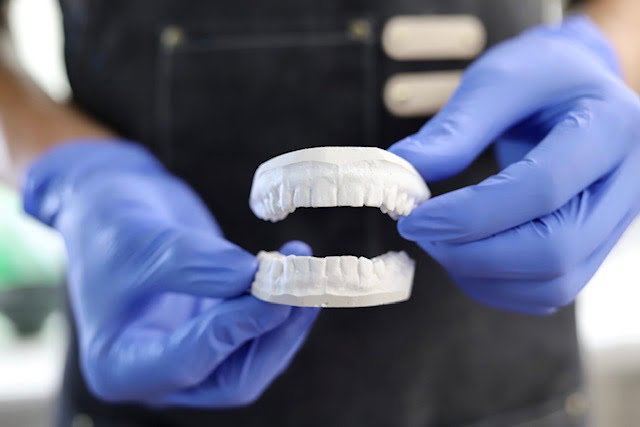Medically reviewed and verified by: Dr. Lara Coseo, (DDS, FAGD) is a 2004 graduate of Baylor College of Dentistry in Dallas, Texas. Having practiced general dentistry for 13 years, Dr. Lara currently serves as an Associate Professor at Texas A&M College of Dentistry.
Upper or lower dental night guard? Which one do I choose?
The short answer is that the decision comes down to preference in most individuals. Wearing a dental night guard on either teeth arch will protect your teeth from damaging effects.
We go into more detail below! Keep reading to learn more so that you can make an informed decision.

-
Product on sale
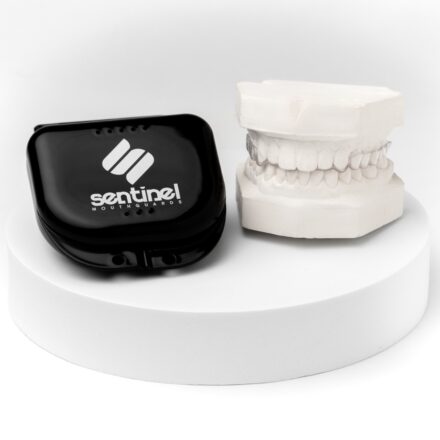 No-Show Day Mouth Guard$129.00
No-Show Day Mouth Guard$129.00 -
Product on sale
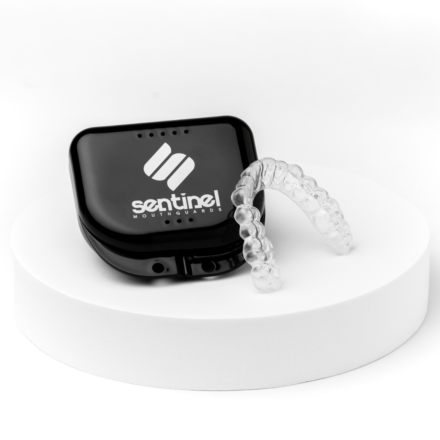 Durability Mouth Guard for Heavy Teeth Grinding$189.00
Durability Mouth Guard for Heavy Teeth Grinding$189.00 -
Product on sale
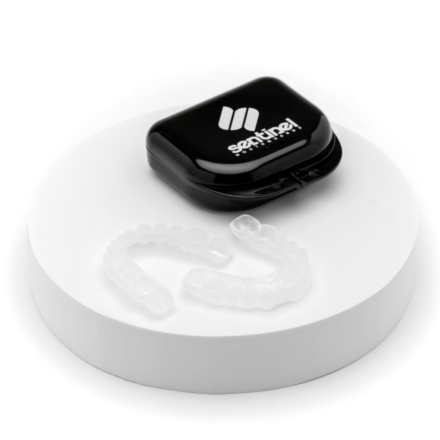 Tongue and Cheek Biting Relief Mouth Guards$169.00
Tongue and Cheek Biting Relief Mouth Guards$169.00 -
Product on sale
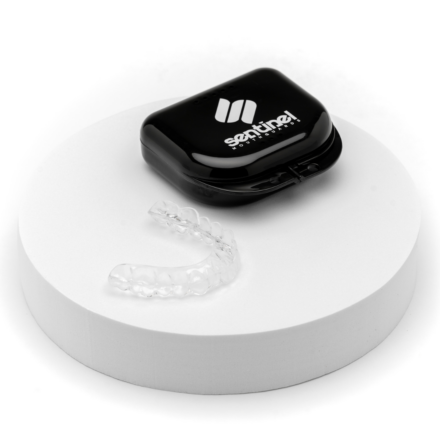 Custom Hard Night Guard$149.00
Custom Hard Night Guard$149.00 -
Product on sale
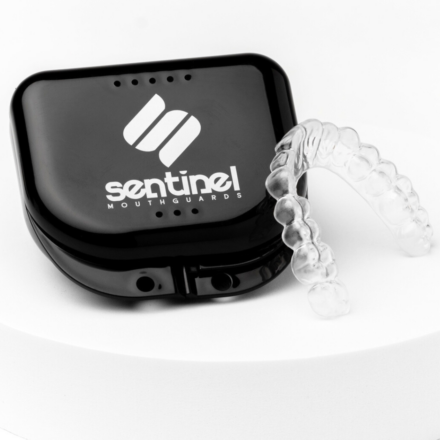 Custom Soft Night Guard$129.00
Custom Soft Night Guard$129.00 -
Product on sale
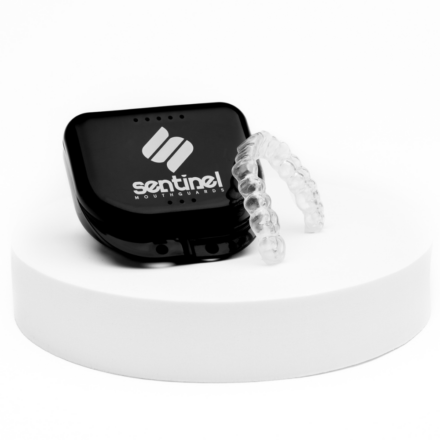 Custom Dual Laminated Night Guard$149.00
Custom Dual Laminated Night Guard$149.00
Why wear a night guard in the first place?
Many people grind or clench their teeth at night during sleep. This is a condition known as nocturnal bruxism. Over time, bruxism can lead to the wearing away of the teeth enamel, as well as a host of other problems such as cracked teeth or jaw pain. After the enamel is worn, this also opens up the opportunity for cavities to form in the teeth.
Although nocturnal bruxism typically can’t be “cured”, there is an easy solution to protect the teeth for those who grind or clench at night in the form of wearing an upper or lower dental night guard. While there are some dental night guards that can be purchased from commercial, big box stores, a bruxer’s best bet is to have one custom made, by your dentist or an online dental night guard lab. This ensures a proper, effective fit that provides comfort and prevents slipping.
How does a night guard work?
The dental night guard acts as a cushioned barrier between the upper and lower teeth, so that while your jaw may still, in fact, be going through the motions of grinding or clenching, the teeth are not making contact with each other which prevents further damage to them.
Wearing a night guard does not CURE teeth grinding.
Yet it effectively saves your teeth from physical harm and can save a person thousands of dollars in dental repair bills. It can also relieve uncomfortable pain that stems from the act of grinding the teeth and clenching the jaw.
Can I wear both an upper and lower night guard simultaneously for maximum protection?
Wearing both an upper and lower night guard simultaneously is not a common or recommended practice. Night guards are designed to provide a protective barrier between the upper and lower teeth, cushioning the impact of grinding or clenching forces on the teeth and jaws. Wearing both types of night guards together may lead to several issues:
- Discomfort and Interference: Wearing two night guards simultaneously can cause discomfort, interfere with proper jaw alignment, and create an unnatural bite relationship. This may lead to additional muscle strain and potentially exacerbate symptoms.
- Speech and Breathing Impairment: Wearing two night guards can affect your speech and may interfere with proper breathing during sleep. It can impede the natural movement of your mouth and tongue, leading to difficulties in speaking and potential breathing disturbances.
- Ineffective Protection: Wearing two night guards does not necessarily provide double the protection. Properly fitting and custom-made night guards, whether upper or lower, are designed to absorb grinding forces and protect your teeth. Wearing both types may not significantly enhance the level of protection and can be unnecessary.
Instead of wearing both upper and lower night guards simultaneously, it is recommended to consult with a dental professional. They can assess your specific condition, evaluate your grinding patterns, and recommend the most suitable type of night guard based on your individual needs. A well-fitted, single night guard can provide effective protection and alleviate symptoms associated with teeth grinding or clenching.
Will an upper night guard or a lower night guard be more comfortable to wear during sleep?
The comfort level of wearing an upper or lower night guard during sleep can vary from person to person. Some individuals may find an upper night guard more comfortable, while others may prefer a lower night guard. Comfort is subjective and can be influenced by factors such as personal preference, jaw anatomy, and individual sensitivity.
That being said, here are some general considerations regarding comfort for both types of night guards:
Upper Night Guard:
- Reduced Tongue Interference: An upper night guard covers the biting surfaces of the upper teeth, which may allow for more freedom of movement for the tongue. This can be preferred by individuals who feel more comfortable with less interference from the guard on their tongue.
- Lesser Salivation Disruption: Some people may experience increased salivation initially when wearing a night guard. An upper night guard may be less likely to trigger excessive salivation compared to a lower night guard.
Lower Night Guard:
- Less Bulky Sensation: A lower night guard tends to be smaller and less intrusive in the mouth, which can provide a perception of less bulkiness. This may be preferable for individuals who are sensitive to having a larger appliance in their upper arch.
- Reduced Gag Reflex: Some individuals may have a more sensitive gag reflex, and wearing a lower night guard may be more comfortable for them as it sits lower in the mouth and may have less impact on triggering the gag reflex.
Ultimately, the most comfortable option will depend on your personal preference and oral anatomy. A well-fitted night guard, regardless of whether it is an upper or lower night guard, is crucial for optimal comfort. Custom-made night guards, fabricated based on dental impressions, tend to provide a better fit and overall comfort compared to over-the-counter or boil-and-bite alternatives.
Do upper and lower night guards have different effects on jaw muscles and TMJ disorders?
Upper and lower night guards can have different effects on jaw muscles and TMJ disorders, although the impact may vary from person to person. Here are some considerations regarding their effects:
- Jaw Muscle Tension: Both upper and lower night guards help reduce jaw muscle tension by providing a cushioning barrier between the upper and lower teeth. This can help alleviate muscle strain and discomfort associated with teeth grinding or clenching.
- TMJ Disorders: TMJ disorders involve dysfunction and pain in the temporomandibular joint. While night guards are not a direct treatment for TMJ disorders, they can indirectly benefit individuals with these conditions. Night guards can help by reducing the intensity of grinding forces and minimizing the impact on the joint, which may provide some relief from TMJ-related symptoms.
- Bite Alignment: Upper night guards may have a slight advantage in influencing bite alignment. If an individual has an overbite or misaligned bite, an upper night guard can help reposition the jaw and promote a more balanced bite relationship. This can provide additional benefits for individuals who experience jaw pain or discomfort due to the misalignment.
- Clenching Control: Both upper and lower night guards can help control clenching by providing a protective barrier between the teeth. However, the specific impact on clenching can vary depending on individual habits and the design of the night guard.
It’s important to note that the effects of night guards on jaw muscles and TMJ disorders can vary based on factors such as the severity of the condition, individual anatomy, and the presence of other contributing factors. Night guards are typically recommended as part of a comprehensive treatment approach that may involve other interventions such as lifestyle modifications, stress management, physical therapy, or medication.
Can an upper night guard or a lower night guard help with teeth clenching as well as grinding?
Yes, both upper and lower night guards can help with both teeth clenching and grinding. Night guards are designed to provide a protective barrier between the upper and lower teeth, cushioning the impact of clenching and grinding forces. They help distribute the pressure more evenly across the teeth and reduce the potential damage caused by these habits.
Here’s how night guards can assist with teeth clenching and grinding:
- Cushioning Effect: Night guards, regardless of whether they are worn on the upper or lower arch, act as a cushioning barrier between the teeth. They absorb some of the forces generated during clenching and grinding, reducing the direct impact on the teeth and minimizing wear and damage.
- Muscle Relaxation: Night guards can help relax the jaw muscles by providing a stable surface to bite against. This can help reduce the intensity of clenching and grinding habits and alleviate muscle tension in the jaw.
- Protective Barrier: Night guards act as a physical barrier that prevents the upper and lower teeth from directly contacting each other. By creating separation between the arches, night guards help minimize the wear and tear that can result from clenching and grinding.
While night guards can effectively manage the effects of teeth clenching and grinding, it’s important to note that they do not treat the underlying causes of these habits. If you’re experiencing persistent clenching or grinding, it’s advisable to consult with a dental professional. They can evaluate your specific condition, identify any contributing factors, and recommend a comprehensive treatment plan that may include a night guard along with other interventions if necessary.
Remember to wear your night guard as directed by your dental professional and maintain regular follow-ups to ensure its effectiveness and address any concerns you may have.
How do upper and lower night guards differ in terms of durability and lifespan?
In terms of durability and lifespan, the durability of upper and lower night guards is generally comparable. However, the specific lifespan can vary depending on factors such as the material used, the level of teeth grinding or clenching, maintenance practices, and the quality of the night guard. Here are some points to consider:
- Material: Night guards are commonly made from different materials, including hard, soft materials, or a combination of both. Hard night guards tend to be more durable and resistant to wear compared to softer materials. However, they may be more prone to breakage if subjected to excessive forces.
- Teeth Grinding or Clenching Intensity: The lifespan of a night guard can be influenced by the intensity of your teeth grinding or clenching habits. Individuals with more severe grinding habits may experience more wear and tear on the night guard, which can impact its durability over time.
- Maintenance and Cleaning: Proper care and maintenance can extend the lifespan of a night guard. Regularly cleaning the night guard with non-abrasive cleaners and avoiding exposure to high heat can help preserve its integrity. Follow the specific care instructions provided by your dental professional to ensure longevity.
- Regular Assessment and Replacement: Night guards should be regularly assessed by a dental professional to determine if they require replacement. Over time, night guards can lose their effectiveness due to wear, changes in bite alignment, or changes in the condition of your teeth and jaws. Your dentist can evaluate the condition of the night guard during routine check-ups and recommend replacement as needed.
The lifespan of a night guard is not fixed and can vary between individuals.
Regular follow-ups with your dental professional and open communication regarding any concerns or issues you may have with the night guard will help ensure its effectiveness and longevity.
Is there a difference in cost between an upper and lower night guard?
The cost difference between an upper and lower night guard can vary depending on several factors, including the dental provider, geographical location, material used, and any additional customization required. However, in general, there is usually no significant cost difference between the two types of night guards.
Should I Buy an Upper Or Lower Night Guard?
Dental night guards can be made for either the upper teeth or the lower teeth, but usually not both.
So how do you choose between an upper or lower night guard?
For common cases of teeth grinding and jaw clenching, most find that either one will provide the same results. The upper dental night guard is still the most common type made, but this may simply be due to a slow progression towards the acceptance & use of lower night guards within the industry.
In other words, it may be that, because the dental night guard was originally made for the upper teeth, dentists/lab technicians are still commonly fabricating the upper teeth guard out of habit or preference for no substantiated reason. Though you will always find varying opinions such as dentists who favor lower guards for their patients who grind their teeth.
Most people will first learn of their bruxing disorder through their dentist, so naturally, they make a follow-up appointment in order to have impressions made for a custom dental night guard.
Once I place my order, how does it work?

We will mail out a dental impression kit for you to take your own impressions at home. You will then mail the impressions back to our lab and we’ll make the custom guard for you. We provide you with a cost-saving solution, without ever having to leave your home! More about this can be found on our FAQs page.
Either way, a custom-made guard provides you with a much better fit than one of the boil and bite versions you might buy from your local pharmacy or retail outlet.
Read on to learn another reason why an upper or lower dental night guard made by a dental professional or lab is far superior to those found in stores!
Made in the USA with the safest materials
Most mouth guards are made from materials such as acetate, rubber, acrylic, or vinyl. You should check to make sure your night guard is BPA, Silicone, and Latex free.
Sentinel Mouthguards are made from BPA, Silicon & Latex FREE material.
EVA (Ethylene – Vinyl Copolymer) is the material used for the Sentinel Soft Dental Night Guard. This product contains no HAPs or ODS & does not contain any chemicals listed under the U.S. Clean Water Act Priority Pollutant and Hazardous Substance List. This product is not considered to be hazardous under the OSHA Hazard Communication Standard and is regulated under Section 311-312 (40 CFR 370). It is safe to use in the mouth on a nightly basis and will not irritate the oral area or skin.
The Sentinel Hard Dental Night Guard is made of a copolyester material. Prolonged contact is non-irritating to the oral cavity or skin. This product also neither contains HAPs or ODS, nor any chemicals listed under the U. S. Clean Water Act Priority Pollutant and Hazardous Substance List and is not considered to be hazardous under the OSHA Hazard Communication Standard.
Finally, the Sentinel Dual-Laminated Night Guard is a combination of both materials stated above and meets all likewise requirements.
Taking your dental impression on the upper teeth and lower teeth
If you opt for a lower dental impression, you’ll notice that the impression tray will look slightly different from an upper teeth impression tray. The lower tray has a “cut out” for your tongue. Follow the instructions exactly as written and you will be sure to get a great impression no matter which teeth arch you choose – ensuring that your upper or lower dental night guard fits like a glove.
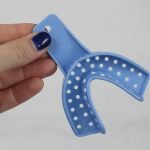
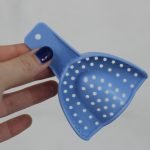
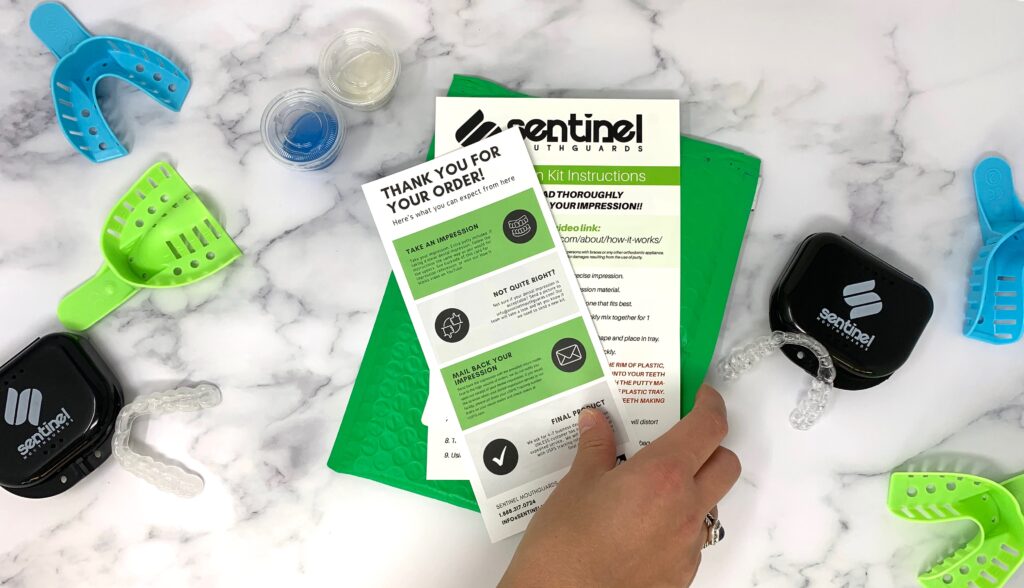
What are the dentists saying?
Here are some varying opinions from dentists on whether to choose an upper or lower night guard:
“Both upper or lower dental night guards serve the same function. They provide a gliding surface for teeth to rub against rather than a direct impact on teeth to teeth. If someone has a gag reflex, we may recommend a lower night guard .” –Mark Bishara, DDS
“After 21 years of making these occlusal guards, I find that lower appliances are better tolerated and provide a significantly better therapeutic effect. 24 hours is all that is necessary to get used to it. The tongue adapts beautifully.” –Marc G. Rothman, DMD
“The design of your dental night guard is dependent on several factors, which might include your bite, the affect on speech or airway, your tolerance for having an appliance in your mouth, or even the preference of your dentist; just to name a few. There is no “right way” that applies to every situation. What is most important is that it fits, is used, and protects your teeth and jaw joint from the destructive forces that can accompany the harmful habits of unconscious grinding. For long term use, the night guard should also cover all the teeth. This kind of design prevents shifting of your teeth and changes to your bite.” –Jonathan F. Richards, DDS
Reference Source: Doctorbase.com
The Bottom Line
Consult your dentist as to whether they feel your individual case would benefit most from an upper or lower night guard. In most cases, it’s simply a matter of getting a well fitting guard that does its job of keeping the upper and lower jaw from coming into contact with each other.

